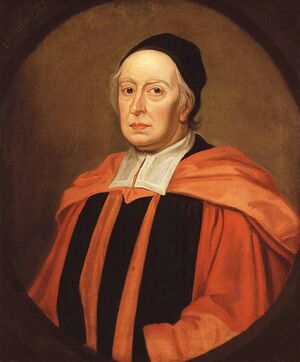John Wallis (nonfiction)
John Wallis (/ˈwɒlɪs, ˈwɔːlɪs/; 3 December 1616 – 8 November 1703) was an English mathematician who is given partial credit for the development of infinitesimal calculus.
Between 1643 and 1689 he served as chief cryptographer for Parliament and, later, the royal court.
He is credited with introducing the symbol ∞ for infinity. He similarly used 1/∞ for an infinitesimal.
As it was intended he should be a doctor, he was sent in 1632 to Emmanuel College, Cambridge. While there, he kept an act on the doctrine of the circulation of the blood; that was said to have been the first occasion in Europe on which this theory was publicly maintained in a disputation. His interests, however, centered on mathematics. He received his Bachelor of Arts degree in 1637 and a Master's in 1640, afterwards entering the priesthood. From 1643 to 1649, he served as a nonvoting scribe at the Westminster Assembly. He was elected to a fellowship at Queens' College, Cambridge in 1644, from which he had to resign following his marriage.
Throughout this time, Wallis had been close to the Parliamentarian party, perhaps as a result of his exposure to Holbeach at Felsted School. He rendered them great practical assistance in deciphering Royalist dispatches. The quality of cryptography at that time was mixed; despite the individual successes of mathematicians such as François Viète, the principles underlying cipher design and analysis were very poorly understood. Most ciphers were ad hoc methods relying on a secret algorithm, as opposed to systems based on a variable key. Wallis realised that the latter were far more secure – even describing them as "unbreakable", though he was not confident enough in this assertion to encourage revealing cryptographic algorithms. He was also concerned about the use of ciphers by foreign powers, refusing, for example, Gottfried Leibniz's request of 1697 to teach Hanoverian students about cryptography.
Returning to London – he had been made chaplain at St Gabriel Fenchurch in 1643 – Wallis joined the group of scientists that was later to evolve into the Royal Society. He was finally able to indulge his mathematical interests, mastering William Oughtred's Clavis Mathematicae in a few weeks in 1647. He soon began to write his own treatises, dealing with a wide range of topics, which he continued for the rest of his life.
Besides his mathematical works he wrote on theology, logic, English grammar and philosophy, and he was involved in devising a system for teaching deaf mutes. William Holder had earlier taught a deaf man, Alexander Popham, to speak "plainly and distinctly, and with a good and graceful tone". Wallis later claimed credit for this, leading Holder to accuse Wallis of "rifling his Neighbours, and adorning himself with their spoyls".
Wallis made significant contributions to trigonometry, calculus, geometry, and the analysis of infinite series. In his Opera Mathematica I (1695) he introduced the term "continued fraction". Wallis rejected as absurd the now usual idea of a negative number as being less than nothing, but accepted the view that it is something greater than infinity. (The argument that negative numbers are greater than infinity involves the quotient {\displaystyle {\frac {1}{x}}} {\frac {1}{x}} and considering what happens as x approaches and then crosses the point x = 0 from the positive side.) Despite this he is generally credited as the originator of the idea of the number line, in which numbers are represented geometrically in a line with the negative numbers represented by lengths opposite in direction to lengths of positive numbers.
In 1655, Wallis published a treatise on conic sections in which they were defined analytically. This was the earliest book in which these curves are considered and defined as curves of the second degree. It helped to remove some of the perceived difficulty and obscurity of René Descartes' work on analytic geometry. In the Treatise on the Conic Sections Wallis popularised the symbol ∞ for infinity.
Arithmetica Infinitorum, the most important of Wallis's works, was published in 1656. In this treatise the methods of analysis of Descartes and Cavalieri were systematized and extended
A few years later, in 1659, Wallis published a tract containing the solution of the problems on the cycloid which had been proposed by Blaise Pascal.
In 1685 Wallis published Algebra, preceded by a historical account of the development of the subject, which contains a great deal of valuable information. The second edition, issued in 1693 and forming the second volume of his Opera, was considerably enlarged. This algebra is noteworthy as containing the first systematic use of formulae.
He is usually credited with the proof of the Pythagorean theorem using similar triangles. However, Thabit Ibn Qurra (AD 901), an Arab mathematician, had produced a generalisation of the Pythagorean theorem applicable to all triangles six centuries earlier. It is a reasonable conjecture that Wallis was aware of Thabit's work.
Wallis was also inspired by the works of Islamic mathematician Sadr al-Tusi, the son of Nasir al-Din al-Tusi, particularly by al-Tusi's book written in AD 1298 on the parallel postulate.
Another aspect of Wallis's mathematical skills was his ability to do mental calculations. He slept badly and often did mental calculations as he lay awake in his bed. One night he calculated in his head the square root of a number with 53 digits. In the morning he dictated the 27-digit square root of the number, still entirely from memory. It was a feat that was considered remarkable, and Henry Oldenburg, the Secretary of the Royal Society, sent a colleague to investigate how Wallis did it.
In the News
Fiction cross-reference
Nonfiction cross-reference
- Bonaventura Cavalieri (nonfiction)
- Cryptography (nonfiction)
- Mathematician (nonfiction)
- Henry Oldenburg (nonfiction)
- William Oughtred (nonfiction)
- François Viète (nonfiction)
External links:
- John Wallis @ Wikipedia
